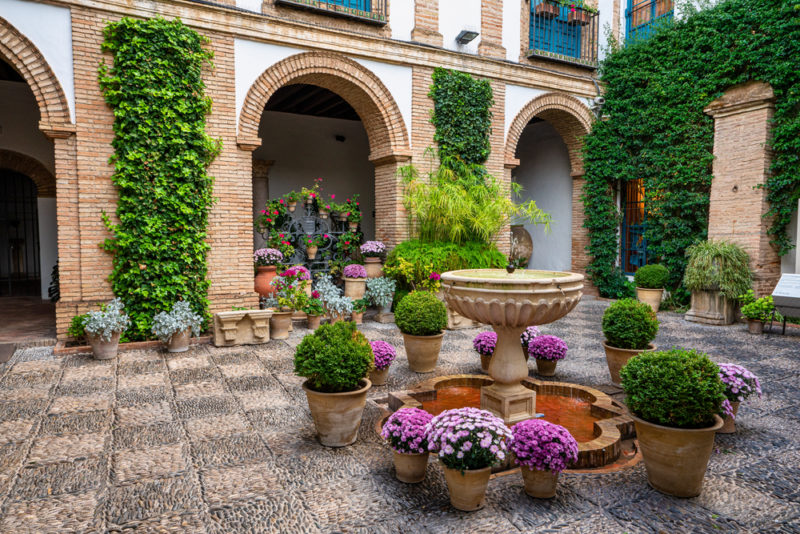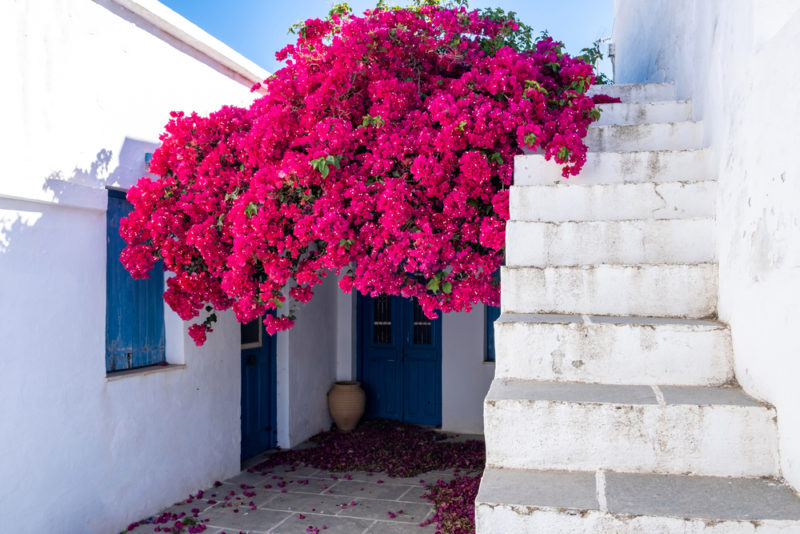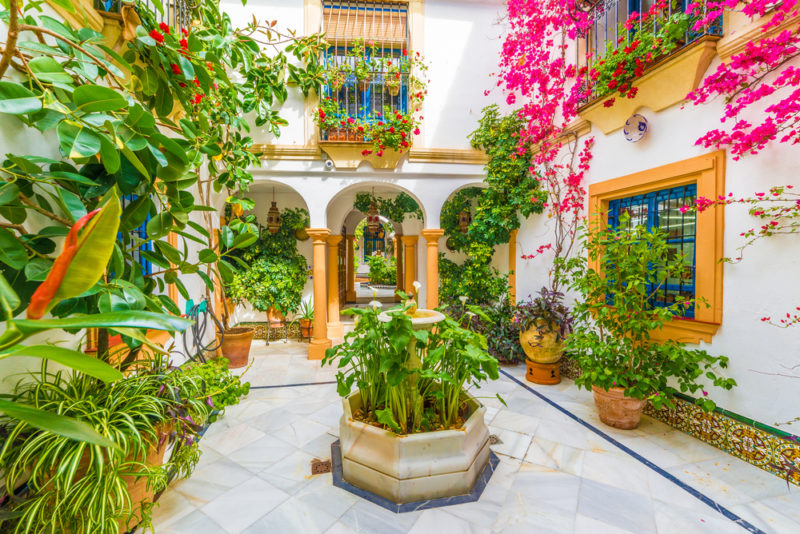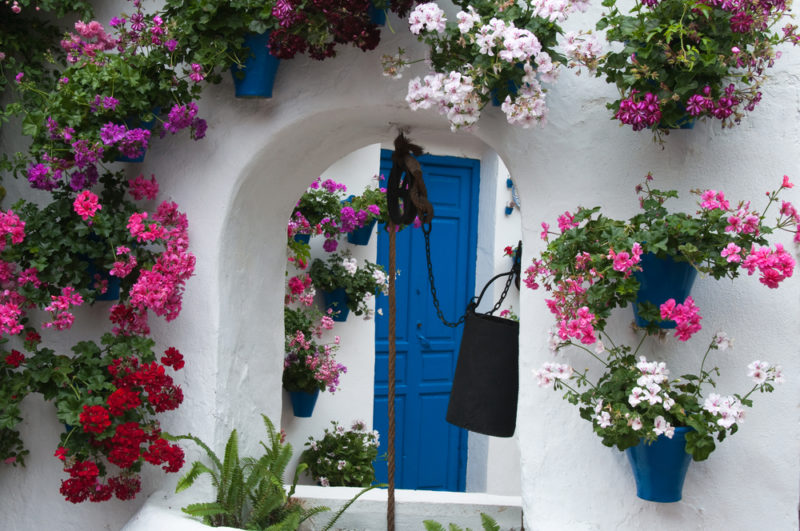When considering the best plants for your Spanish garden, prepare to intertwine beauty and serenity in perfect harmony. Unveiling magnetic elements that define styles of gardens in Spain from Spring through to winter, Spanish gardens overflow with fragrant flowers and leaves, painting mesmerizing tapestries of colours. A Spanish garden is where nature and human ingenuity create sensory wonderlands.
Vibrant colours, captivating scents, terracotta plants, and architectural marvels transport visitors to a cultural and visual bounty. Spanish gardens leave indelible imprints, whether admiring intricate tilework or simply basking in tranquillity. This article looks at perfect plants that withstand hot temperatures, tips for eye-catching gardens with plants and where to get inspiration.
Best Plants for Spanish Gardens
Succulents and Cacti of Spain
Succulent plants and cacti complement Spanish gardens. They thrive in the Mediterranean sun, bursting with colours to complement any landscape. Whether you prefer wild, untamed leaves or an orderly arrangement, these plants bring texture and life to terraces and gardens in Spain. Succulent plants come in various shapes and sizes.
Although they require regular watering, cacti don’t. Both succulents and cacti also make ideal pot plants in Spain. For succulents, think about any member of the sedum or sempervivum families. Ghost plants and certain species of echeveria also like Spanish temperatures. For stunning displays, invest in the rare Myrtillocactus geometrizans cacti.
Shrubs, Vines and Flowering Plants
Spanish gardens always boast of flowering garden plants, which bring splashes of colour to every corner. Choose from classic blooms, such as roses, lavender, poppies, and dahlias, or opt for more exotic varieties like bougainvillaea and jacaranda. Add some evergreen shrubs that remain vibrant all year round for lush looks but check whether they need daily watering.
Popular choices in spain include agapanthus, hibiscus, and the hardy oleander plants. For softening vertical surfaces and defining spaces, look no further than shrubs and vines. Hardy evergreens like boxwood or ivy gracefully climb up walls or create hedges. Climbing plants like jasmine, honeysuckle, or bougainvillaea can also grow up walls and fences for added texture and dimension.
Go Nuts for Nut Trees
Spanish landscapes are graced with nut trees that provide shade and tasty treats. Almond, pistachio, and walnut trees provide fragrant foliage and lovely blossoms throughout the year. These trees also bear fruit, adding delicious bounties to gardens. Average evergreen trees provide an abundance of nuts in summer and don’t need watering during the Spanish winter.
Huge Leaves on Evergreen Trees
For Spanish gardens with an old-world feel, add some trees. Olive and citrus trees bring Mediterranean charm to outdoor spaces, while majestic palms give tropical vibes. For something more interesting, try an evergreen oak or almond tree. These grand specimens will be the crowning glory of your Spanish garden, creating breathtaking backdrops. No matter your chosen plants, your Spanish garden will be full of life and beauty. It will be your favourite spot with captivating colours, scents, and textures.
Edible Fruits and Vegetables of Spain
Fruit trees and vegetables are vital to any Spanish garden, adding colour, aroma, and flavour. There’s something for everyone in this bounty for healthy snacks or eye-catching centrepieces. For salads, consider planting sky-high tomato plants with bright red fruit or crisp lettuce. Peppers come in several shapes and sizes to add pizzazz to dishes. At the same time, juicy oranges and limes bring Mediterranean Spain to your doorstep. If you have significant amounts of space, also consider fig trees.
Fragrant Herbs Of Spain for Flavour
They add flavour to cooking, and herbs bring character and beauty to landscapes. Consider planting fragrant lavender, rosemary, oregano, thyme, and basil for an aromatic addition to terraces and gardens. These herbs attract butterflies and bees while filling the air with their delightful scents. For something more ornamental, plant flowering sage or chamomile for colour and texture. Whatever herbs you choose, enjoy the bounty of your Mediterranean Spanish paradise! Herbs also make ideal pot plants.
Common Palm Trees for Green Foliage
Finally, common palm trees are also common in Spanish gardens. Whether you opt for the classic fan or spiky needle palm, these graceful plants bring the tropics to outdoor spaces during hot summers. The majestic Mediterranean palm, which can grow up to 25 feet tall, is a beautiful addition. It will become the garden centre point and draw admirers from near and far. The added advantage of evergreen tree palms is they don’t need watering in winter.
Aromatic Plant of Lavender
So, that is groups of plants to consider, but what specific plants fare well in a Spanish garden. A good starter is lavender. For aromatic flowers, lavender is popular in Mediterranean gardens, and fragrant blooms bring sophistication to terraces. Lavender comes in several hues – from soft lilacs to purples – that create show-stopping displays. Plus, their heady aroma delights the senses! For low-maintenance plants with maximum impact, this is the one for you!
Beautiful Flowers from the Passion Flower
Ah, the passion flower – an excellent plant in Spanish gardens. This beautiful plant offers vibrant colours, leaves and intricate shapes. Passion flowers range from deep blues and purples to bright yellows and oranges. And their unique blooms create impressive displays! Plus, these stunning plants thrive in Spain with minimal effort.
Drought Tolerant Bougainvillea
For showstopper leaves and flowers, bougainvillaea loves Spanish temperatures and starts to bloom from late spring onwards. Cascading clusters of pink, purple, red, and white blooms create stunning displays. Plus, its fast-growing nature means you’ll be able to enjoy its beauty in no time.
Whether you plant it against a wall or as a stand-alone bush, this plant attracts attention and admiration. With a choice of white flowers, purple flowers, pink and many more, this show stopper blooms right through to late summer months and grows up to 20 feet tall.
Showy Flowers of Hibiscus
There’s something exceptional about hibiscus. This colourful bloom brings cool summer vibes to outdoor spaces with showy petals, green leaves and vibrant colours. Whether you choose deep red, soft pink, or orange blossom, these delicate flowers look stunning in Spanish gardens. They’re effortless to care for – requiring minimal pruning while withstanding temperatures.
Sikas Cycas – The Garden Center Piece
This delightful plant draws attention from everyone. Huge leaves – from dark green to deep blue – have beautiful textured patterns that add sophistication to Mediterranean paradises. The Sikas Cycas is the perfect addition to Spanish gardens for exotic beauty.
Drought Resistant Kalanchoe
When adding exotic to Spanish gardens during warm temperatures, nothing beats Kalanchoe! Its leathery leaves have stunning patterns that make for impressive displays. Long-lasting blooms during mild winters keep gardens looking stunning for weeks. Kalanchoe is another one for pot plants that thrive in Spain.
Yucca and Ornamental Garden Plants
Yucca is definitely a must-have for Spanish gardens and indoor plants that are drought resistant! This iconic plant of Mediterranean gardens highlights dry garden spaces. Their hardy nature means they’ll thrive in warm temperatures and cool summers with minimal care and maintenance! Yuccas are also easy to care for and love periods of drought. This is perfect for low-maintenance plants that like dry soils and warm climates.
Complete the Spanish Garden Style
Architectural Elements of Spain: Architectural brilliance is at the heart of every Spanish garden. Elaborate terracotta and stone structures, gracefully adorned with intricate details, serve as focal points. Arched doorways, stately pillars, and wrought iron gates provide grandeur, inviting visitors to explore hidden leaves within.
Refreshing Water Features: Gentle murmurs of water is a constant companion in a Spanish garden, lending soothing ambiences. Ornate fountains adorned with playful sculptures or mosaic tiles anchor the space, emanating a sense of tranquillity and cool summers. Meandering streams and serene reflecting pools invite contemplation, while delicate splashes of waterfalls add enchantment.
Lush Greenery of Spain: Lush greenery flourishes in Spanish gardens. Towering cypress trees and graceful palm fronds provide shade and structure. At the same time, neatly trimmed hedges delineate pathways and separate different sections. Citrus groves, with their aromatic lemon, orange, and lime trees, add delightful fragrances and vivid green to landscapes.
Intricate Tilework and Paved Courtyards: Spanish gardens always feature stunning tilework, a legacy of Spain’s Moorish influences. Intricate geometric patterns and ceramic tiles adorn walkways, patios, and courtyards, creating a feast for the eyes.
Intimate Seating Areas and Al Fresco Dining: Spanish gardens embrace leisure and conviviality. Nestled amidst greenery, seating areas offer cosy corners for solitude or private conversations. Al fresco dining spaces, often shaded by pergolas, beckon visitors to savour local cuisine while surrounded by nature’s splendour, creating unforgettable dining experiences.
Colour of Spain: From gorgeous Gerbera Daisies to beautiful Verbena, Spanish gardens wouldn’t be complete without beautiful flowers and green leaves. For maximum impact, choose various colours and heights— mix bold and bright blooms with softer pastels to create balance and visual interest. Add seasonal colour by planting annuals like petunias, the red carnation national flower of Spain, or zinnias for summertime splashes of hues.
Helpful Tips for Gardening in Spain
Understand Mediterranean Climates: Spain’s varied temperate climate ranges from Mediterranean to semi-arid and even alpine in some regions. Learn about the area’s climate to determine suitable plants and gardening techniques. Take note of average temperatures, rainfall patterns, dry climates, and growing seasons.
Water Wisely: Many parts of Spain experience hot and dry summers, making water conservation crucial. Install efficient irrigation systems like drip irrigation to minimize water waste. Water deeply but infrequently to encourage plant roots to grow deeper, making them more resilient during dry periods. Consider using mulch to retain moisture and prevent weed growth. Also, use well-drained soil mix if using pots.
Select Drought-Tolerant Plants: Opt for plants well-suited to local climates. Choose drought-tolerant species like lavender, rosemary, succulents, and Mediterranean herbs. These plants can withstand long periods of heat and require less water, making them ideal choices for Spanish gardens.
Native and Mediterranean Plants: Native plants are well-adapted to local environments and require less maintenance. Incorporate Mediterranean plants like bougainvillaea, oleander, agapanthus, and cypress trees, which thrive in Spanish climates and cold winters. They add bright colours and authenticity.
Soil Preparation: Assess soil quality and amend accordingly. Spanish soils can vary significantly, ranging from sandy to clayey compositions. Add organic matter like compost, well-rotted manure, or peat moss to improve soil structure, drainage, and fertility. Conduct soil tests to determine any nutrient deficiencies and adjust accordingly. Poor soils hamper plants’ growth. While some say acidic soil doesn’t matter, experts check PH levels.
Extreme Temperatures of Spain: Extreme heat and cold can pose challenges for gardeners in Spain. During hot summers, provide shade for delicate plants using shade cloths or plant them in areas with natural shade. In colder regions, protect frost-sensitive plants by covering them with blankets or using protective structures like greenhouses or cold frames.
Pest and Disease Management: Regularly inspect plants for signs of pests and diseases. Implement integrated pest management strategies, such as using beneficial insects, natural repellents, or organic pesticides when necessary. Proper sanitation, good airflow, and plant hygiene can help prevent diseases.
Pruning and Maintenance: Regular pruning promotes healthy growth and improves overall appearance. Prune plants during their dormant period to maintain shape, remove dead or damaged branches, and stimulate new growth. Stay vigilant with weed control to prevent them from competing with your desired plants for resources.
Comply with Local Regulations: Check local regulations or restrictions on gardening practices. Some regions may have specific guidelines regarding water usage, plant species, or pesticide usage. Ensure you abide by these regulations to maintain sustainable and environmentally friendly gardens.
Learn from Local Expertise: Engage with fellow gardeners to exchange knowledge, tips, and specific experiences. Local nurseries and garden centres also provide valuable plant selection and care advice.
Lastly, remember gardening is about continuous learning. Embrace experimentation, observe unique conditions and adapt techniques accordingly. With patience, care, and trial and error, you can create thriving and beautiful gardens in Spain.
Need Inspiration? Famous Gardens in Spain
Generalife Gardens, Alhambra – Granada: Located within the Alhambra complex, Generalife Tropical Gardens highlight Moorish Garden design. These stunning gardens feature terraces, beautiful flowers, courtyards, fountains, ornamental plants, and lush greenery, creating serene beauty and tranquillity.
Alcázar Gardens – Seville: Alcázar Tropical Gardens, part of the Alcázar of Seville, showcase Moorish and Renaissance influences. Known for their intricate tilework, tranquil ponds, fragrant orange trees, and meticulously manicured hedges, these gardens are gorgeous.
Royal Botanical Tropical Garden – Madrid: The Royal Botanical Garden, spanning 20 hectares, was established in the 18th century and features plant species worldwide, charming walking paths, and beautifully landscaped sections.
Park Güell – Barcelona: Designed by the famous architect Antoni Gaudí, Park Güell in Barcelona showcases Gaudí’s distinctive style and creativity. The tropical garden features mosaic-covered structures, winding pathways, and lush greens, offering breathtaking views and whimsical atmospheres.
Alcázar of Córdoba: Situated within the historic Alcázar of Córdoba, this tropical garden showcases Islamic influence in Spain. With terraces, courtyards, water features, palm trees and fragrant flowers, these gardens create peaceful retreats.
Marimurtra Botanical Garden – Blanes: Located on the Costa Brava, the Marimurtra Botanical Tropical Garden is known for its stunning coastal views and an extensive collection of Mediterranean and subtropical plants. Terraces, cliffs, and meandering pathways provide unique opportunities to explore diverse flora while enjoying breathtaking vistas.
Gardens of La Granja – Segovia: Situated near the Royal Palace of La Granja de San Ildefonso in Segovia, these formal gardens are renowned for their Baroque design and elegant geometric layouts. They feature beautifully sculpted hedges, ornate fountains, statues, and flower beds.
Royal Monastery of San Lorenzo de El Escorial Gardens – Madrid: The tropical gardens surrounding the Royal Monastery of El Escorial offer blended Renaissance and traditional Spanish garden design. With some beautiful plants for Spanish gardens, the tranquil ponds, and sculpted hedges, also complement architectural splendour.
More Reading About Spain
Best Places to Live in Andalusia: Andalusia presents one of the most popular retirement destinations in the world. Living in Andalusia, Spain, offers enriching experiences with laid-back Mediterranean lifestyles, a warm climate, beautiful landscapes, and welcoming communities. Abundant sunshine also creates year-round outdoor lifestyles for beach days, mountain hiking, or exploring villages.
Beautiful Places in Spain: Whether you want to live there or visit, the list of beautiful places in Spain presents a unique country offering much to anyone who wants to experience everything in this corner of Europe. Of course, some incredible places and towns in Spain, like Andalusia, Malaga, Madrid, Barcelona, the Costa del Sol, Cordoba, and Ronda, rank as the most visited and earn international travel fame. But some hidden gems also stop everyone in their tracks.















